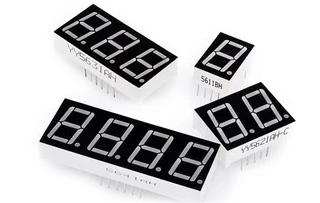
In today's world, where electronic devices are everywhere, digital displays have become a key interface between humans and machines. Among these, seven-segment displays stand out as a classic, reliable, and cost-effective solution for showing numbers. They continue to play an irreplaceable role in industrial control, home appliances, and instrumentation. From simple digital clocks to complex industrial equipment, this display technology uses a clever combination of seven light-emitting segments to clearly present numerical information.
Even as advanced display technologies like TFT color LCDs become more common, seven-segment displays still hold their ground thanks to their simplicity, reliability, low power consumption, and cost-effectiveness. This article dives into seven-segment displays, covering an overview, definition, working principle, differences from four-segment displays, and more.
Catalog
I. What is a Seven-Segment Display?
III. Four-Segment vs. Seven-Segment Displays
I. What is a Seven-Segment Display?
A seven-segment display (SSD) is an electronic component used to show numbers, with light-emitting diodes (LEDs) as its building blocks. It displays decimal digits 0–9 by lighting up different combinations of its seven segments, labeled a through g. Many seven-segment displays also include a small dot in the lower-right corner for decimal points, which is why they're sometimes referred to as "eight-segment displays."
There are two main connection types:
· Common Anode: All the positive terminals (anodes) of the LEDs are connected together to a high voltage. Each segment lights up when its negative terminal (cathode) is pulled low.
· Common Cathode: All the negative terminals are tied together to ground. Segments light up when their anodes receive a high voltage.
This flexibility allows seven-segment displays to work with a variety of driving circuits.
II. Work Principles
The core idea behind a seven-segment display is simple: each of the seven LED segments can be turned on or off in combinations to show numbers. Each segment is essentially an LED that lights up when the right amount of current passes through it.
The display is controlled using an external driver circuit or a dedicated decoder chip, which converts incoming binary signals (like BCD codes) into the signals that drive each segment.
· For common-anode displays, the common terminal is connected to a high voltage, and segments light up when their cathodes are pulled low.
· For common-cathode displays, the common terminal is grounded, and segments light up when their anodes are driven high.
By selectively lighting different combinations of segments, the display can represent digits 0–9 and even some letters.
III. Four-Segment vs. Seven-Segment Displays
Besides seven-segment displays, there are also four-segment displays and other types, which differ in structure and use:
· Four-segment displays are limited in what they can show. With only four segments, they can display fewer numbers and symbols and are generally used in simple applications.
· Seven-segment displays, on the other hand, offer:
· Greater flexibility: They can show all digits from 0–9 and even some letters.
· Broader applications: They’re widely used where clear numerical display is essential—industrial instruments, measurement devices, appliance panels, and more.
· Mature technology: After years of development, seven-segment displays have a variety of mature driving and control solutions.
There are also 14-segment and 16-segment displays, which add diagonal strokes to better display letters and other symbols. However, with the drop in price of dot-matrix displays, these multi-segment types have largely been replaced.
IV. Conclusion
Seven-segment displays remain a classic and essential technology in the electronics industry. Their reliability, affordability, and practicality ensure they continue to thrive in digital display applications. Understanding their working principles and suitable use cases is valuable for engineers, product designers, and anyone studying electronics.
As technology continues to advance, seven-segment displays are evolving to meet new application requirements and environmental challenges. In the foreseeable future, they will continue to play an important role in industrial control, appliance displays, instrumentation, and more, providing clear and dependable numerical information for electronic devices.
When choosing a display solution, it's crucial to consider your specific needs: if you only need to show simple numbers or characters and have strict power or cost limits, seven-segment displays are often the ideal choice. For complex images or full-color content, more advanced technologies like TFT LCDs may be necessary.




